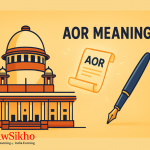Complete guide to criminal complaint format in India with downloadable templates for Section 223 (200 CrPC) & 175(3) BNSS (156 CrPC). Learn drafting, documents required & filing procedure.
Table of Contents
When Should You File a Criminal Complaint?
Let me start with an example. Parth runs a small electronics shop in Mumbai. One evening, his business partner Rushabh withdraws ₹5 lakhs from their joint account and disappears. Parth rushes to the police station with bank statements, partnership documents, and WhatsApp messages showing Rushabh’s fraudulent intent.
The police officer shrugs: “This is a civil dispute between partners. We can’t register an FIR. Go to the civil court.”
Frustrated, Parth takes a different route: he files a criminal complaint directly before the Magistrate under Section 210 of BNSS (formerly Section 190 of CrPC). Within two weeks, the Magistrate examines him, reviews his evidence, and issues summons to Rushabh for criminal breach of trust.
This is exactly when you need a criminal complaint:
You should file a criminal complaint when you’ve been a victim of a crime and the police refuse to register your FIR, or when the offense is non-cognizable requiring a Magistrate’s intervention.
A criminal complaint is also appropriate when you have substantial evidence ready: like Parth’s bank statements and messages: and prefer the court to examine it directly rather than relying on police investigation. This legal remedy empowers you to approach the Magistrate with your version of events, supported by documents and witnesses, allowing the court to determine whether sufficient grounds exist to proceed against the accused.
The bottom line: When police won’t help or you want judicial scrutiny from day one, the criminal complaint is your constitutional right to seek justice directly.
Criminal Complaint Format: Essential Components
A properly structured criminal complaint follows a standardized format that Indian courts recognize and process efficiently. Understanding each essential component helps you present your case clearly and increases the likelihood of the Magistrate taking cognizance of your complaint.
Now, let me walk you through the mandatory elements that every criminal complaint must contain for it to be legally valid and procedurally complete.
Court Header and Case Number
The complaint must begin with the court’s full name centered at the top (“IN THE COURT OF THE CHIEF JUDICIAL MAGISTRATE / METROPOLITAN MAGISTRATE AT [City Name]”), followed by a blank space for the case number that will be assigned upon filing (“Complaint Case No. ______ of 20__”).
This identification section establishes which court has jurisdiction and creates an official record reference for all future proceedings in your case.
Details of Complainant and Accused
Below the case number, clearly identify both parties with the complainant’s full name, parentage (son/daughter/wife of), complete address, age, and occupation on the left side, the word “VERSUS” in the center, and the accused person’s similar details on the right side. If the accused’s complete details are unknown, mention whatever information you have along with “identity and address to be ascertained”.
You can click on any of the criminal complaint formats below to see how the parties are mentioned in a criminal complaint.
Statement of Facts
The statement of facts forms the core of your complaint and must be presented in chronologically numbered paragraphs.
- Start with your self-introduction establishing your credentials as a law-abiding citizen in paragraph 1;
- Describe the accused person and your relationship with them in paragraph 2;
- Narrate the background circumstances leading to the offense in paragraphs 3-4;
- Detail the actual wrongful act committed with specific date, time, and place in paragraphs 5-8;
- Specify the offence ingredients with relevant sections under Bharatiya Nyaya Sanhita 2023 sections in paragraphs 9-10;
- Describe any attempts to resolve the matter or report to police and how police failed to act on your complaint in paragraphs 11-12; and
- Establish jurisdiction and limitation in paragraphs 13-14.
Each paragraph should state one clear fact without emotional language or legal arguments. Use specific details rather than vague assertions: instead of writing “the accused assaulted me,” state “on 15.08.2024 at 7:30 PM at XYZ Road, the accused struck me three times on my left shoulder with a wooden stick causing bruises and swelling.” Reference supporting documents within the factual narrative using phrases like “copy of medical certificate dated 16.08.2024 is annexed as Annexure-A” to link each assertion with corroborating evidence.
The factual allegations must establish all ingredients of the offense you’re charging. For instance, when you are alleging cheating, you must show: (1) deception by the accused through false representation, (2) dishonest inducement to deliver property or valuable security, (3) actual delivery of property based on that deception, and (4) the accused’s knowledge that the representation was false. Without demonstrating each element through specific facts, the Magistrate may dismiss your complaint for not disclosing a cognizable offense.
The chronological narration should flow logically from introduction through the offense to the current situation. Avoid jumping between time periods or presenting facts out of sequence, as this confuses the Magistrate during examination
Jurisdiction and Limitation
You must explicitly state why the particular court has territorial jurisdiction over the offense: “The offense was committed within the territorial limits of this Hon’ble Court at [specific location, police station area].” According to Section 197 of BNSS (formerly Section 177 of CrPC), every offense must ordinarily be tried by a court within whose local limits it was committed, though certain offenses like cheating or criminal breach of trust may be tried where the offense was completed or where the property was delivered.
Prayer and Relief Sought
The prayer section specifies what action you want the court to take: “It is most respectfully prayed that this Hon’ble Court may be pleased to: (a) Take cognizance of the offense under Section [X] and [Y] of BNS, 2023; (b) Issue summons/warrant to the accused directing them to appear before this Hon’ble Court; (c) Try the accused for the said offenses and award appropriate punishment according to law; (d) Pass such other orders as deemed fit in the interest of justice.”
Verification
Every complaint must conclude with a verification clause: “I, [your full name], the complainant above-named, do hereby verify that the contents of paragraphs 1 to [X] above are true and correct to the best of my knowledge and belief, and nothing material has been concealed therefrom.” Sign below this statement with your full name, place, and date. The Magistrate will examine you on oath regarding these statements, so ensure every fact you verify is truthful and accurate to avoid prosecution for giving false evidence.

Criminal Complaint Format: Types
The Bharatiya Nagarik Suraksha Sanhita recognizes two primary types of criminal complaints based on your objective:
Section 210 BNSS (formerly Section 190 of CrPC) for direct Magistrate cognizance leading to trial;
Section 175(4) of BNSS (formerly Section 156(3) of CrPC) for ordering police investigation when they’ve refused to register an FIR. Understanding when to use each format and how to draft them correctly is critical for effective legal recourse. Now let us discuss these types in greater detail below.
Criminal Complaint under Section 210 of BNSS (formerly Section 190 CrPC)
You should file a criminal complaint under Section 210 of BNSS (formerly Section 190 of CrPC) when you want the Magistrate to directly take cognizance of an offense and proceed with trial without police investigation.
This mode is appropriate for non-cognizable offenses where police cannot investigate without the Magistrate’s order, situations where you’ve already gathered sufficient evidence and witnesses, cases involving private disputes like defamation or assault between known parties, or when you prefer judicial inquiry over police investigation which may be biased or delayed.
Section 223 of BNSS (formerly Section 200 of CrPC) empowers any Magistrate to examine the complainant and witnesses upon oath before deciding whether the allegations disclose an offense warranting further proceedings. According to the Supreme Court in Pepsi Foods Ltd. v. Special Judicial Magistrate [(1998) 5 SCC 749], the Magistrate must apply judicial mind to determine if the allegations, if proved, would constitute an offense the test is not whether the allegations will be proved at trial, but whether they disclose commission of a cognizable offense requiring the accused to answer.
One commonly resorts to this provision for offenses under such as hurt and grievous hurt, criminal intimidation, defamation, matrimonial offenses, dishonor of cheques under the Negotiable Instruments Act 1888, and other offenses where the complainant has direct knowledge and documentary evidence.
Criminal Complaint under Section 175(4) of BNSS (formerly Section 156(3) CrPC)
When to Use Section 175(4)
Section 175(3) of BNSS (previously Section 156(3) CrPC) is your powerful legal remedy when police refuse to register FIR despite a cognizable offense being committed. This provision empowers any Magistrate to order police investigation even when police have declined to act.
You can resort to this provision when the police refuse to register FIR citing lack of evidence or jurisdiction issues, the offense is clearly cognizable but police claim it’s civil in nature, you’ve approached higher police officials (Superintendent of Police or Commissioner) without result, or you want the Magistrate to direct police investigation.
The Supreme Court in Lalita Kumari v. Government of Uttar Pradesh (2014 2 SCC 01) held that registration of FIR is mandatory for cognizable offenses, and if police refuse, the aggrieved person can approach the Magistrate under Section 156(3).
This format differs fundamentally from the criminal complaint under Section 210 of BNSS because you’re not asking the Magistrate to take cognizance and conduct trial, you’re requesting an administrative order directing police to register FIR and investigate. The Magistrate exercises supervisory power under Section 175(3), not judicial power. After investigation, police submits a report, and then the Magistrate decides on cognizance based on police findings.

Criminal Complaint Format in India: Documents Required for Filing
Proper documentation significantly strengthens your criminal complaint and increases the likelihood of the Magistrate taking cognizance. Courts rely heavily on supporting evidence to determine whether a prima facie case exists, and inadequate documentation is one of the primary reasons complaints get dismissed. Understanding what documents to attach, how to organize them systematically, and how to reference them properly in your complaint narrative is essential for successful prosecution.
Mandatory Documents Checklist
Every criminal complaint must include certain mandatory documents without which the complaint may be rejected at the filing stage.
- First, attach your identity proof (Aadhaar card, PAN card, passport, or driving license with clear photograph) establishing your name and address to verify you are the person filing the complaint.
- Second, include address proof (electricity bill, property tax receipt, or rent agreement) corresponding to the address mentioned in the complaint to establish the court’s jurisdiction over you as the complainant.
- For offense-specific documents: In assault cases, obtain a medical certificate from a government hospital detailing injury nature, examination date, and medical opinion on whether injuries could have been caused as alleged.
- In cheating cases, attach all financial transaction proof including bank statements, NEFT/RTGS confirmations, payment receipts, and agreements showing money transferred to accused;
- In criminal intimidation cases, preserve threat evidence like WhatsApp/SMS screenshots, email printouts, or audio recordings with transcriptions and date-time stamps visible;
- In defamation cases, attach the defamatory material (newspaper clipping, social media screenshot with URL and date) proving publication to third parties.
- If you reported to police previously, attach your written complaint to police with a stamp or DD number, any police reply explaining FIR refusal, and complaints to senior police officials (SP/Commissioner) with receiving proof.
How to Prepare and Organise Annexures?
Proper annexure organization follows a systematic convention that courts expect and facilitates easy reference during examination. Mark each supporting document as “Annexure-A”, “Annexure-B”, “Annexure-C” in the sequence you reference them in complaint paragraphs – never skip alphabets or use random numbering.
At the top right corner of each page, write clearly in ink: “Annexure-[Alphabet]” and if the document has multiple pages, mark them as “Annexure-A (Page 1 of 3)”, “Annexure-A (Page 2 of 3)” ensuring pages cannot be removed or added without detection.
Create an index sheet titled “LIST OF ANNEXURES” listing all documents with descriptions like “Annexure-A: Medical certificate dated 15.08.2024 issued by Dr. Sharma, Civil Hospital” so the court quickly identifies each annexure’s contents.
For original documents you cannot submit (like Aadhaar or medical reports needed for records), make clear photocopies and get them certified by a notary public or oath commissioner who will attest “True copy of the original” with signature and seal – under Section 79 of Bharatiya Sakshya Adhiniyam 2023, certified copies have evidentiary value. For digital evidence like screenshots or emails, print them in color showing date-time stamps and sender details, then get them notarized with a certificate stating “This is a true screenshot of digital communication taken from my device on [date]” – without certification, digital evidence may be challenged for authenticity as explained in by the Hon’ble Supreme Court in the judgment of Anvar P.V. v. P.K. Basheer [2014 AIR SCW 5695].
How to Give Reference of Annexures in the Criminal Complaint?
When drafting complaints, paragraphs reference annexures using precise language that directs the court’s attention to specific evidence supporting each assertion. After stating a fact, immediately cite the relevant annexure: “A copy of the medical certificate dated 20.08.2024 showing injuries sustained is annexed herewith and marked as Annexure-A” or “Screenshots of threatening messages received on 15.08.2024 are annexed as Annexure-D (Colly. of 3 pages)” where “Colly.” indicates collection of related documents.
Common Drafting Mistakes to Avoid in Criminal Complaint
Even with strong facts and evidence, poorly drafted complaints get dismissed due to technical defects or procedural errors. Understanding common mistakes helps you avoid them and ensures your complaint withstands legal scrutiny during Magistrate examination. These errors frequently result in Section 226 of BNSS (formerly under Section 203 of CrPC) dismissals where the Magistrate finds insufficient grounds to proceed despite the underlying merit of your grievance, wasting time and resources while the accused remains unpunished.
Vague or Incomplete Facts
One of the most frequent reasons for complaint dismissal is vague factual narration without specific details of date, time, place, and manner of offense commission.
Example: Writing “the accused assaulted me last month near my house and caused injuries” is legally insufficient because it doesn’t specify the exact date (which month? which day?), precise time (morning/afternoon/evening?), exact location (which street/landmark?), or manner of assault (with weapon? with hands? single blow or multiple? Which body parts were targeted?). Allegations must be specific enough that if proved, they would constitute the offense charged: vague allegations cannot establish offense ingredients and give the accused no clear charge to defend against.
Wrong or Missing Legal Provisions
Incorrectly citing legal provisions or omitting essential offense sections weakens your complaint’s legal foundation and may result in charges being framed for lesser offenses than facts warrant.
Example: Filing complaint for physical assault causing broken bones but citing only Section 115 BNS (voluntarily causing hurt – imprisonment up to 1 year) instead of Section 117 BNS (voluntarily causing grievous hurt – imprisonment up to 7 years) because fractures constitute “grievous hurt”.
Missing Evidence References
Failing to attach supporting documents or not referencing them in complaint paragraphs leaves your factual assertions appearing as unsubstantiated allegations rather than provable facts.
Example: In a cheating complaint, stating “I paid Rs. 5 lakhs to the accused but he never delivered goods” without attaching and citing bank transfer receipts showing payment, invoice or agreement showing what was promised, email correspondence confirming the transaction, and legal notice sent demanding performance makes your claim seem like a mere allegation.
Jurisdiction Errors
Filing your complaint in the wrong court due to territorial or pecuniary jurisdiction mistakes leads to dismissal or transfer delays wasting months.
Example: Filing complaint for offense that occurred in Noida (Uttar Pradesh) before Patiala House Court in Delhi just because you reside in Delhi will result in the complaint being returned or transferred, as Section 197 of BNSS (formerly section Section 177 of CrPC) mandates that offenses must ordinarily be tried by courts within whose local limits they were committed: even if it’s inconvenient for you to travel to Noida court, jurisdiction rules are mandatory and cannot be waived by consent or convenience.

Samples of Criminal Complaint Format
Section 210 of BNSS Complaint
Three threatening messages. One ignored a police complaint. But a Section 210 criminal complaint format that couldn’t be dismissed. See what made the difference in this criminal intimidation case.
Section 175 (4) of BNSS Criminal
When ₹5 lakhs disappeared and police refused to act, this wasn’t the end; it was just the beginning. This Section 175(4) criminal complaint format turned rejection into investigation. See exactly how it was done.
Conclusion
Filing a criminal complaint is a fundamental right that empowers every citizen to seek judicial intervention when wronged by criminal conduct, whether the police acts or not. This comprehensive guide has equipped you with complete knowledge of criminal complaint formats – from understanding when to use Section 210 under BNSS for direct Magistrate cognizance versus Section 175(4) under BNSS for police investigation orders, to structuring factual allegations chronologically with proper legal provisions, to organizing documentary evidence as annexures with correct references. The key to a successful complaint lies in three critical elements: specific, dated factual narration avoiding vague allegations; proper citation of applicable BNS sections with evidence establishing each offense ingredient; and comprehensive supporting documentation properly numbered, certified, and referenced.
Remember that criminal complaints trigger the machinery of criminal justice potentially resulting in investigation, prosecution, and conviction with serious consequences for the accused, so ensure every fact stated is truthful and verifiable as filing false complaints or giving false evidence attracts prosecution.
If uncertain about legal provisions, court jurisdiction, or procedural technicalities, consult a criminal lawyer who can review your complaint before filing and representation. The legal system provides multiple remedies for crime victims through police FIR, direct Magistrate complaints, or court-ordered investigations, and understanding these formats empowers you to access justice effectively while protecting your rights throughout the criminal justice process from complaint filing through trial to judgment.
Frequently Asked Questions on Criminal Complaint
What is the difference between FIR and criminal complaint?
An FIR is registered by police for cognizable offenses triggering immediate investigation with possible arrest without warrant. A criminal complaint is filed directly before a Magistrate for any offense, requiring examination on oath before cognizance.
Can I file a criminal complaint online in India?
Several states offer online filing through integrated court systems. However, complaints require physical filing at court with proper documentation and court fee stamps in addition to e-filing. Click here to understand the process of physical filing and e-filing process better.
What is the court fee for filing a criminal complaint?
Court fees vary by state, typically ranging from Rs. 20 to Rs. 200 depending on offense seriousness. Most states charge Rs. 50-100 – check your state’s Court Fees Act or court registry for exact fees.
How long does it take for a Magistrate to take cognizance of a complaint?
After filing a criminal complaint, Magistrates typically examine the complainant within 7-15 days and may take cognizance immediately or order an inquiry taking 30-60 days. Total timeline varies from 2 weeks to 3 months depending on court workload.
What Happens After Filing a criminal complaint?
The Magistrate examines you and witnesses on oath to verify the correctness of allegations. If satisfied, they take cognizance and issue summons or warrant, then trial proceeds with charge framing, evidence recording, arguments, and judgment.
Can I file a complaint if the police refuse to register an FIR?
Yes, file a complaint under Section 175(4) BNSS before the Magistrate requesting court to direct police to register FIR and investigate.
What happens if my criminal complaint is dismissed?
File revision petition before Sessions Court within 30 days challenging dismissal on grounds of legal error. Alternatively, file writ petition under Article 226 of the Constitution of India in High Court seeking quashing of dismissal and directions to reconsider.
Do I need a lawyer to file a criminal complaint?
You can file yourself without a lawyer as law permits self-representation. However, engaging a criminal lawyer is advisable for complex cases, proper format compliance, strategic evidence presentation, and effective examination.
Can I withdraw a criminal complaint after filing?
For compoundable offenses, file an application to compound with the accused’s consent. For non-compoundable offenses like murder or rape, withdrawal requires special court permission based on compromise, which court may refuse if offense affects society.
What is the limitation period for filing a criminal complaint?
No statutory limitation for most offenses, though delay weakens cases.
How to file a complaint for a non-cognizable offence?
File a criminal complaint directly to the Magistrate. Thereafter, the Magistrate examines you on oath and if satisfied, takes cognizance and conducts inquiry or orders police investigation.






 Allow notifications
Allow notifications
